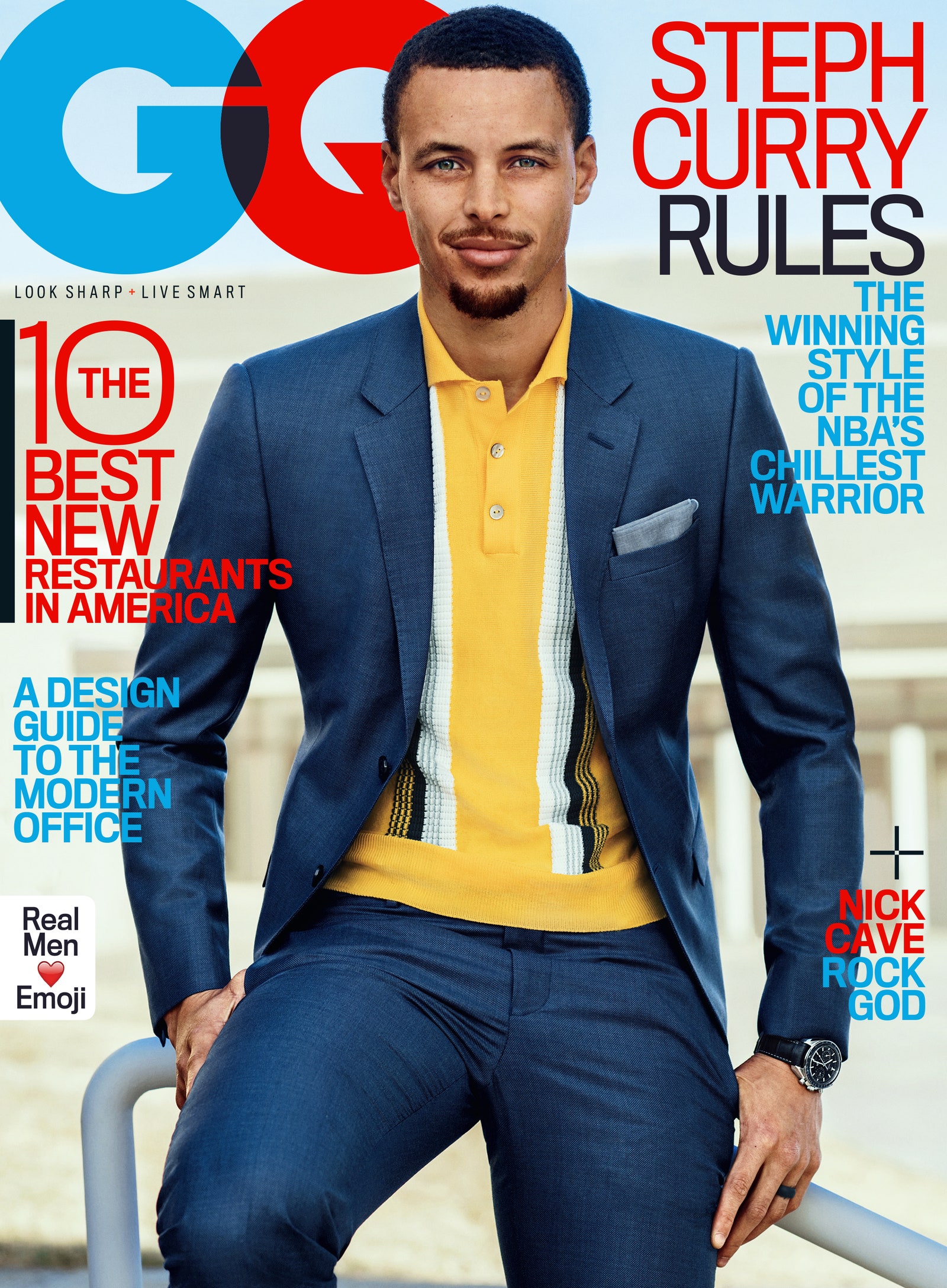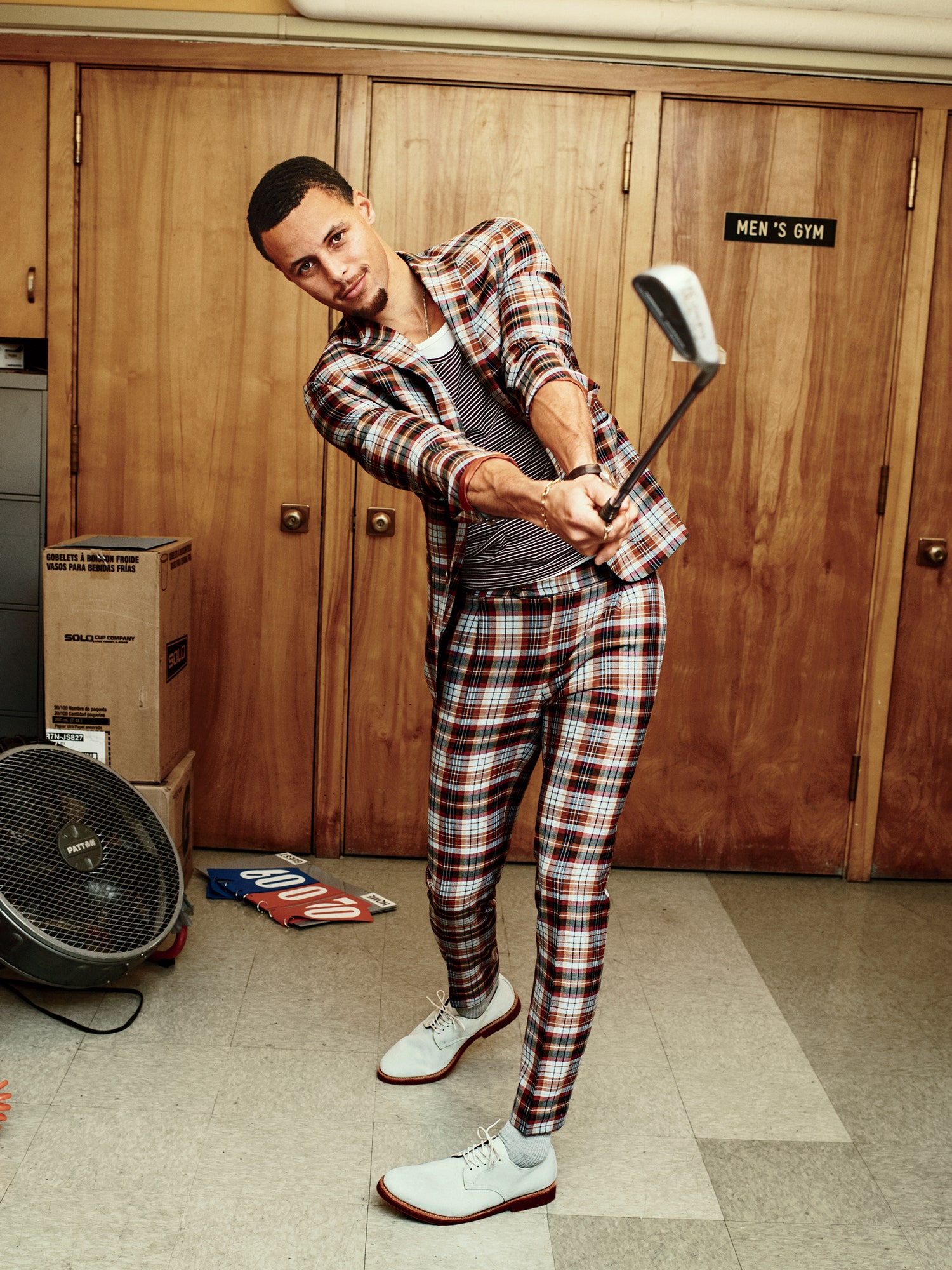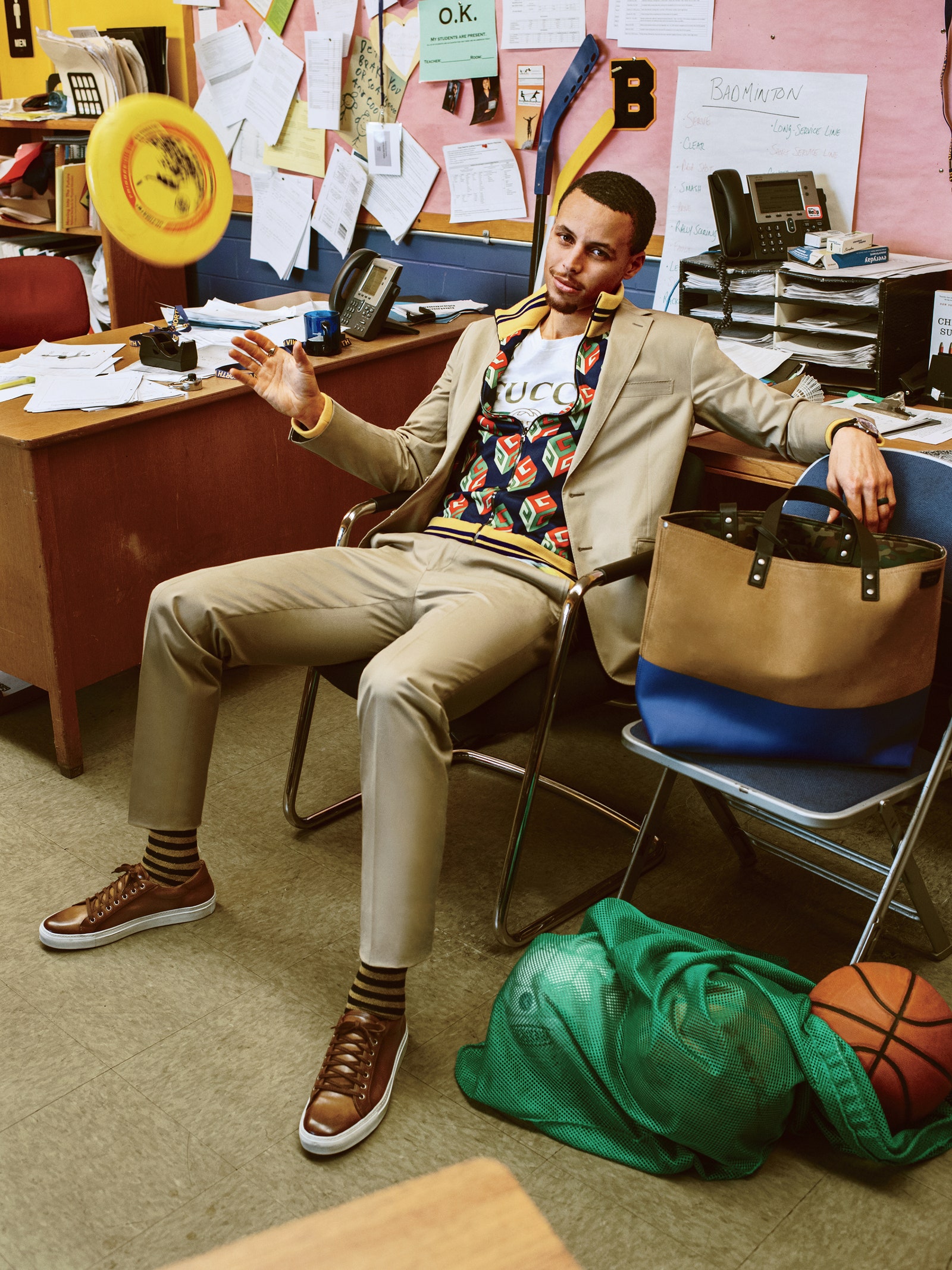Steph Curry says he plays better when he’s feeling joyous. But how will the league’s best shooter face the postseason after his team’s unprecedented collapse in last year’s NBA finals? Andrew Corsello asks Curry how he keeps his cool and swats away the nightmares as he tries to set the record straight about which franchise is the most dominant force in basketball.
e doesn’t pass the eye test. He never has. I know this about him going in—the coaches and scouts who dismissed him because he didn’t play right, didn’t act right, didn’t look right. One early scouting report reads like a series of taunts from the Bully of the Beach in the old Charles Atlas comic strips:
“Far below NBA standard in regard to explosiveness and athleticism…extremely small…needs to add some muscles to his upper body, but appears as though he’ll always be skinny…not a natural point guard that an NBA team can rely on to run a team.”
And yet when I meet the man this spring, at the Golden State Warriors practice facility, my eyes tell me what they tell me and I think, like so many before me, and quite stupidly: Uh, I thought Stephen Curry would be bigger.
As I lurk behind the goalpost, dazzled and half hypnotized by the shhhick!…shhhick!…shhhick! (a sound sibilant and crisp and, somehow, grinning) as he sinks 35 three-point shots in a row, the nay-saying thoughts about Curry and the Goliaths he’s going to meet in the playoffs assert themselves. His vertical leap is a whole foot shorter than Russell Westbrook’s.… LeBron James outweighs him by 60 pounds.…
Even Curry is not immune to such doubts. “Would I have told you my rookie year, ‘I’m gonna be MVP someday’? No way,” he says. “I didn’t know what the ceiling was.”
Does he now? Do we? Curry knows he has unfinished business to attend to this season before any question about his ceiling can be addressed, just as he knows the world is watching and wondering. Yet in practice he radiates nothing but balletic ease. (His record for consecutive threes is 77; he considers any day in which he sinks fewer than 80 out of 100 to be an off day, an ugly day.) The display is impressive, of course, but it’s also quite beautiful.

Curry himself, even before he gets a basketball in his hands and starts to move, is a beautiful human being. And “beautiful,” not “handsome,” is the correct word here. Teammates and opponents both used to describe Michael Jordan as a hard man, and he looked and acted the part: cut from stone, built for combat. Curry, on the other hand, is a Warrior who looks nothing like a warrior. He’s 29 but still baby-faced, with soft sunny features and bright green-gray eyes. There’s an optimistic cast to his face—he looks like he’s smiling even when he’s not. Or, as Warriors head coach Steve Kerr says, “Steph looks like he’s 12 years old.”

But it’s the sight of Curry in motion that hypnotizes. The 100-shot progression resembles an étude rather than a drill. One assistant coach, Nick U’Ren, places himself under the hoop, secures each ball after it shhhicks the net, and distributes it to another assistant coach, Bruce Fraser—known as the Curry Whisperer—who fires passes to his shooter from different positions, constantly varying angle, speed, and arc. Curry remains in perpetual motion, releasing every three seconds or so, slowly tracing the half orbit of the three-point arc from one corner to the other. The exactitude of his footwork—the way the tips of his Under Armour sneakers depart and land exactly an inch from the arc with every shot—creates the impression that he’s negotiating a tightrope, not a painted line.
He doesn’t achieve much air on his jump shot. The question that raises (Why aren’t half this guy’s shots blocked?) gets answered with every ball Fraser feeds him: The hands! The speed with which Curry can receive a pass and transition it into a shot is simply astonishing—to the naked eye he often seems to be volleying, rather than catching, the ball.
“I’ve always suspected he has extra nerves in his fingertips,” says U’Ren. “His ability to manipulate and adjust the ball in a fraction of a second, to transition the angle or arc of his shot in response to what a defender is doing, is unlike anything I’ve ever seen.”
“Steph has an almost superhuman ability to micro-self-correct on his own,” Fraser adds. “But then if one of us says, ‘Try this,’ he’s able to process the change faster than anyone I’ve ever seen. He’s the most educable player I’ve ever known—both in terms of his willingness to listen and in his ability to absorb and execute.”
That soft touch, that combination of finesse and pliancy of temperament—it’s Curry’s singular gift, but it’s also the source of all the talk over the years that he’s, well, soft. It’s instructive (and unavoidable) to compare Curry in this regard to his nemesis. LeBron James, the league’s other generational talent, is an unstoppable blunt-force trauma of a player, but he has none of Curry’s silkiness and grace. There’s something dancerly about Curry’s athleticism. He’s one of the few players in the history of the game capable of producing the illusion that he can change the direction of his body after leaving the ground.

Suit, $2,070, Emporio Armani / Tank top, $115, by Hilfiger Edition / Sneakers, $130, by UAS / Necklace by David Yurman / Bracelet by A.P.C.
“The one downside to Stephen Curry, if you insist on looking for one,” Fraser says, “is that he sometimes loses focus.” It’s true: Throughout the drill, Curry’s eyes are everywhere. Draymond Green is 40 feet away, telling a reporter that despite the double technical he landed the week before, “I am not a bad boy, I’m just Draymond!”—and Curry chimes in, “S’right, Dray! Tell ’em!” Kevin Durant is down the floor practicing pirouettes, ball in hand, to improve his balance and core strength—and Curry finds the time to chirp, “Dance, KD, dance!” The three-point arc no longer evokes a tightrope so much as a satellite dish with which Curry insists on receiving every stray transmission in his environment.
Fraser says there are two reasons for Curry’s distractibility: “One, because everything is so easy for him. And two, because he’s got this childlike quality, which can cause him to lose focus more than some of the others. The thing is, even though this ‘kid’ in him sometimes hurts him, it’s also his best quality, because it makes him joyful. And when Stephen Curry is joyful, he is an assassin.”
It’s a revealing observation, given that the Warriors ended last year’s season with what was arguably the greatest loss of focus in NBA history—becoming the first team to blow a championship series after leading three games to one. “I gave it a lot of thought, and it was like a recurring nightmare for a while,” Curry tells me. “But then, you know, you live your life and do your thing.”
As the Warriors head toward a seemingly inevitable third championship series against the Cavs, the question is whether Curry doing his thing is going to cut it. Can finesse and joy, no matter how fine, no matter how joyful, ever again be enough to take down the big bully in the east?

Suit, $3,395, Belvest + striped tank, $78, by Todd Snyder / White tank by $40 (for three) Calvin Klein by Underwear / Shoes $100 Walk-Over / Socks by Gold Toe / Necklace Renvi by bracelet Cartier
On paper, Stephen Curry’s last two seasons have been what statisticians term “just straight-up stupid.” In 2015, he won his first ring and MVP honors after setting an NBA single-season record of 286 three-point shots. He then doubled down in the off-season (those Cirque du Soleil drills where he dribbles a basketball with one hand while juggling a tennis ball with the other!) and returned staggeringly better in 2016, repeating as MVP while contending for the league’s most-improved honor. To stick some metrics on it: Curry bettered his points-per-game average by 6.3 while going Bob Beamon on his own three-point record, raising the tally from 286 to 402. Four hundred and two.
Yet the numbers, garish as they are, can’t speak to the full Curry effect. Truly great basketball players, the kind that come around only two or three times a decade, have the ability to decide, usually in the fourth quarter, when their team is down and it’s now or never, to flip a switch. Magic, Bird, and Jordan could do it. LeBron can do it. Curry can, too—but, as is so often the case with him, in a new and different way. With LeBron, the thought balloon above his head invariably says one thing: It’s up to me. I’m taking over. The level of ego is as colossal as it is justified.
When Stephen Curry takes over, the moment presents differently. Sometimes, he puts himself in the captain’s seat, as in Game 4 of last year’s Western Conference Semifinals against the Trail Blazers, when he scored 17 points in the five-minute overtime period—another NBA record. (After the game, Charles Barkley, a frequent Curry critic, described what he’d just seen perfectly: “That. What I. That. That was a. That. That was on.”) Other times, Klay Thompson or Kevin Durant or Draymond Green is for all appearances the one taking charge—although it’s unmistakably, if indescribably, clear that Curry is the one engineering the takeover. It’s as if there’s a hive mind at work, with Curry the first among equals. At times, the Warriors’ choreography becomes so much faster than the speed of thought, so intricately loomed, that the score almost—almost—seems besides the point.
“A lot of people who become celebrated athletes were groomed and raised to be in the position they’re in. But that didn’t happen with Steph.”
I ask Curry what it feels like to orchestrate something like that, and his answer is characteristically modest: “Me and Kevin were talking about it on the bench during the fourth quarter yesterday,” he says, referring to the 50 points the Warriors scored in the third quarter against the Clippers. “There was a moment where me and him took over. It wasn’t forced. There was a flow to it. There are times when it happens with this team with more than one person, and sometimes all five. I don’t know what it is, but it is very…unusual.”

Suit, $2,330, by Dsquared2 + sweater, $1,100 / Loafers, $695, by Gucci / Location (throughout) North High School, Denver

Suit, $1,195, shoes, $550, by Ralph Lauren + track jacket $1,750 / T-shirt, $420, by Gucci / Socks by American Trench / Watch by Cartier / Bag (on chair) by Jack Spade




